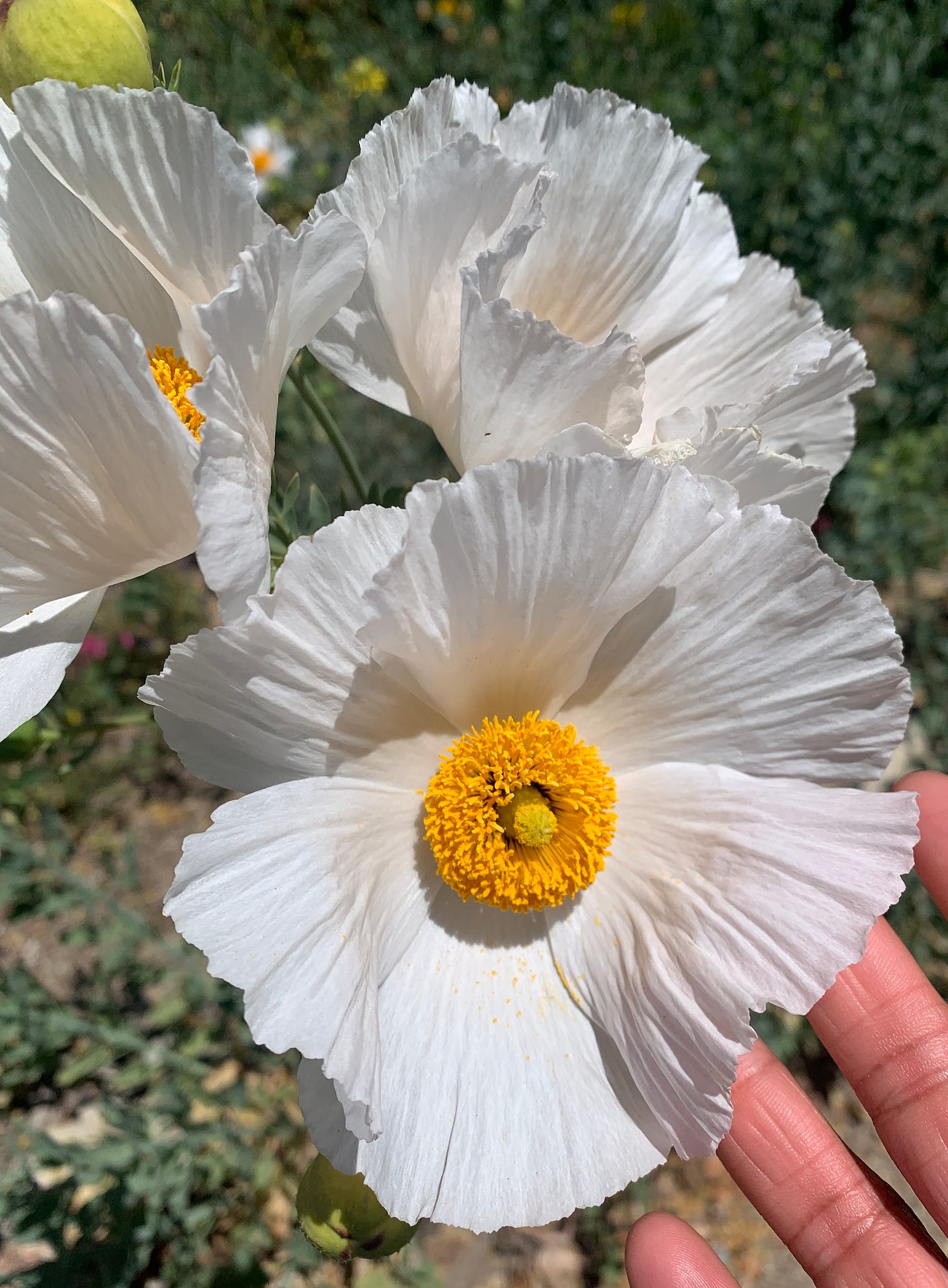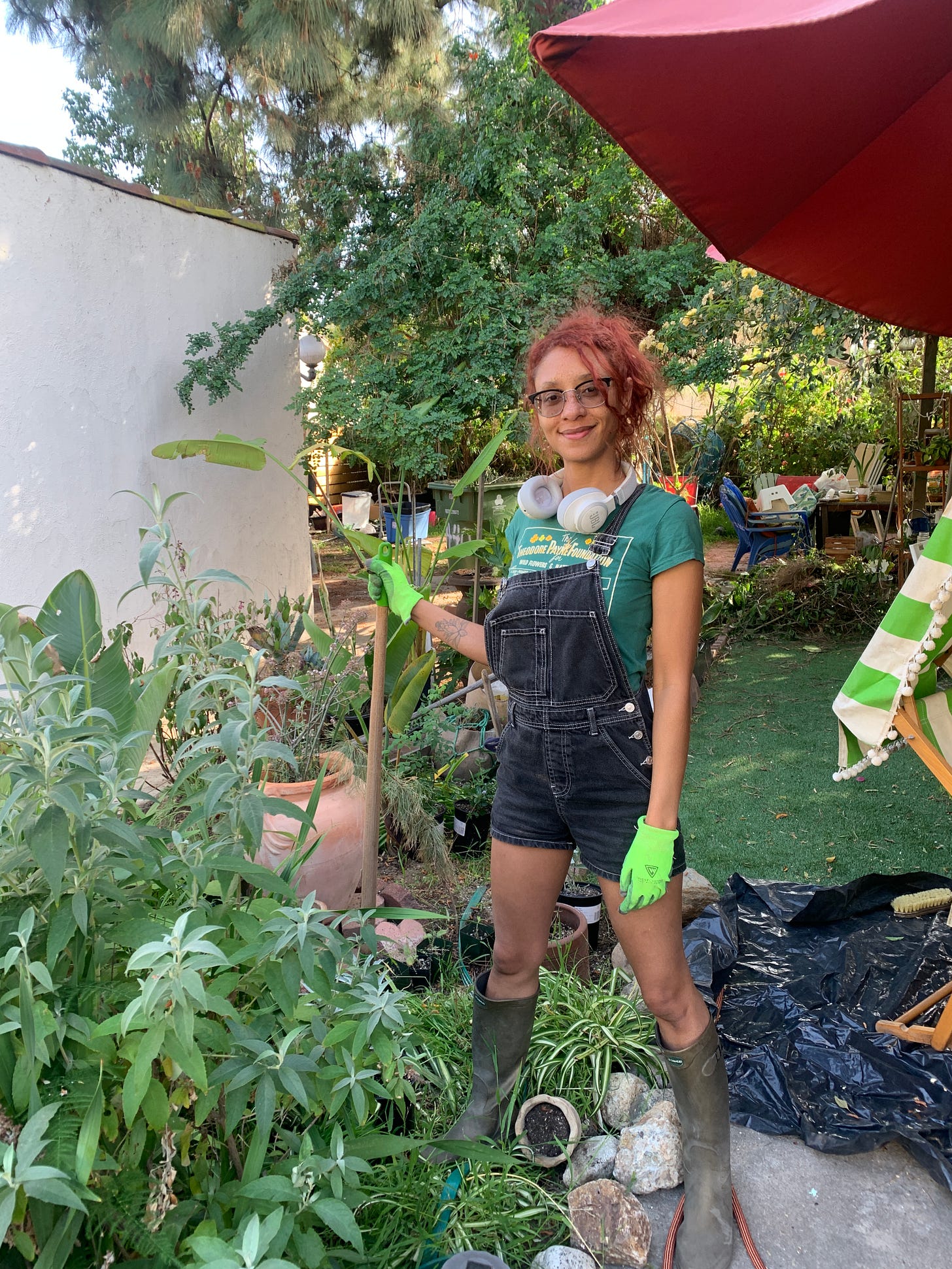The magic of hyper-specific gardening advice, and a whopper of a rambling rose for your trellis
‘If you broke the root ball in May or later it’s over. Good luck, Bob’
My garden got the memo last month. Leading up to spring equinox I was having a hard time getting excited about it and even started to wonder if this whole spring thing might be overrated. Maybe that’s an outrageous thing for a gardener to admit. I was feeling this not because I live in LA where the weather’s nice, but because when you’re barreling into an autocracy, every new day — and beautiful new season — is spiked with dread.
But then on March 20 I really could feel and appreciate the first day of spring. My flowers were blooming in a lot of layers, like in those kids’ books with transparent pages. In the backyard, the hot pink of the bougainvillea makes a bridge with the blue potato bush and bounces down to the cool purple Spanish bluebells. Flashing in the background was our first California poppy of the season. (For the last three years, the one in the painted clay container has outpaced the poppies in the ground.)
As for another California native plant I grow and love…I would describe my Euphorbia xanti as “freaky cottagecore.” Also known as a cherry blossom euphorbia and Baja spurge, its flowers change color, going from deep bubble gum during the chilly spring to almost white when it warms up in July.
They bloom in clusters on Martian-green sticks that jut out like antennae. The flowers smell wonderful, jasmine-y, and attract native pollinators, including hoverflies whose larvae eat up the aphids bound for nearby roses and edible greens.
Bringing some contrasting shapes are the palmate leaves and tropical-looking flowers of Malva ‘Purisima.’ You’d think this hibiscus cousin is from the Caribbean, but it’s actually native to the foggy Channel Islands.
Meanwhile, our climbing rose is a massive buttered popcorn cloud on top of the pergola. (If you’re a pergola/trellis/archway/arbor/gazebo enjoyer looking for an alternative to wisteria, which can aggressively self-seed and is mostly toxic, this climbing rose might be the one for you, but be prepared to prune because it gets HUGE.) I usually don’t name my plants, but deep in my heart this Lady Banks rambling rose is named Aunt Viv.
In January during the fires, the plants were dried and skeletal. Today every shade of green is represented. Even the all-encrusting pollen from our Canary Island pine is a dusty chartreuse.
I walk outside and feel like a little crouton at the bottom of a great big bowl of salad.
Spring also adds new layers to conversations we have out in the street. Try hating small talk when it involves pointing at flowers! Chatting with our tattoo-artist neighbor about her new crop of ranunculus was an almost psychedelic experience at 9 AM.
“Wow, snapdragons are never really on my radar,” is the kind of thing that only spring can inspire you to blurt out.
My little Matilija poppy is trembling with that spring sense of possibility. This is my third attempt at growing this plant, Romneya coulteri, also known as a fried-egg poppy.
The first two times, the little starter plants stagnated and sort of vanished into the weeds. I’d planted them with techniques based on habit — e.g. lots of pumice in the ground because many California native plants need drainage — and without looking anything up. That was my first mistake.


I’m not great at following gardening advice. I’m in a dangerous zone in my gardening journey where I’m not a newbie — the first plant I overwatered was a lavender more than 15 years ago; from there, propagating succulents gave me confidence. But, a few UCLA Extension courses aside, I’m also not a horticulturist.
Some days it comes down to not wanting to take off my dirty gloves to look something up on my phone. I don’t want to go inside and take off my boots to look something up on my laptop. I often plant plants too close together. Eh, it’s probably fine, I’ll think as I dump a shot glass of fish emulsion into a leaky watering can.
But after I bought my third Matilija1 in a 4-inch pot, I was determined not to waste more money on another fried-egg poppy flop. So when I saw a post about them on Instagram from a nursery whose very name is Matilija, I asked what’s tea when it comes to keeping these guys alive.
The nursery2 team replied.
The root balls. I had loosened them quite a bit the first two failed attempts because that’s what I’ve been in the habit of doing for the last decade and a half. One of those previous plantings might also have happened during “May or later.” (Over.)
To state the obvious — being vivid and/or funny when giving advice or asking for something is a diplomatic move. It really does help get people onboard.3 It helps people remember stuff, like a jingle.
You might know about the storybook levels of ornateness in biodynamic gardening. Like: (1) take the manure of a lactating cow (2) stuff that manure into horns originating from cows that ~ideally~ have calved at least once (3) bury the horns two fingers apart, opening side down, (4) unearth them in the month of April, etc. The pseudoscience’s benefits on crop yields have been debunked, but biodynamic wine did inspire a great flashback in this new sommelier thriller “Côte de Nuits,” a short story by James Kaelan.
Compare that with the dishy, almost call-and-response descriptions and care tips in the catalogs of legendary nursery Annie’s Annuals (which has experienced some recent upheaval). They describe their orchid cream nasturtium: “Like nature’s little Rorschach test. What will this Nasturtium say about you? That you love edible flowers?! That you love a front of the bed, flowering plant that will spill and thrill for months?!”
Whereas Matilija’s advice was telling me to get my shit together, Annie’s is an invitation to party. (Check out Oakland Garden Club’s ode to Annie’s here.)
And then there’s the old permaculture saying I think about a lot when I’m devising a mini paradise for our backyard lizards, who love sunning stones, hideouts and eating pests: “You don’t have a grasshopper problem, you have a turkey shortage.”
Sometimes, though, good gardening advice is simply telling you — to your face — not to grow something. Like, don’t plant something that’s invasive in your area.
You might end up telling yourself not to plant something after looking at your USDA Hardiness Zone. Or you might join the legions of “zone pushers” who pull off feats of outdoor growing, like maintaining a golden barrel cactus in Albany or a windmill palm in Spokane. They’ve got plenty of burlap wrapping and mulching tips to go around.
It’s a balancing act. You gotta eat your vegetables (ask the OGs) but also throw petals to the wind (add some compost here and there, see how it goes). Be daring but not dumb, attentive but not intimidated. Figure out how gardening fits in with the larger ecosystem that is your life and the world.
I followed that Instagram reply advice to the mf letter.
And today my little Matilija has more than tripled in size and is strong and cute with robust new growth. Hopefully someday we’ll have some fried-egg poppy flowers that we can see through our kitchen window.
Thanks, Bob.
Matilija (pronounced mah-TILL-uh-hah) poppies are named after Chief Matilija of the Chumash peoples (source).
It reminds me of my friend/former coworker Melissa, who circa 2013 would would add zany gifs and kooky selfies to her many email nudges about impending marketing deadlines, and honestly…I couldn’t get annoyed.














Oh, I'm excited about this new Substack. :)